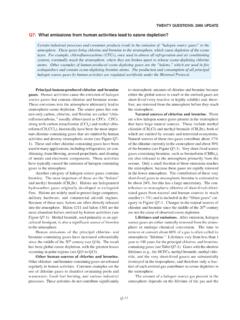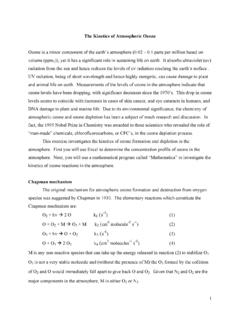Transcription of What is Ozone? Timeline of Stratospheric Ozone Depletion ...
1 What is Ozone ? Ozone (O3) is a molecule made up of three atoms of oxygen (O), and is mostly found in the strato-sphere, where it protects us from the Sun s harmful ultraviolet (UV) radiation. Although it represents only a tiny fraction of the atmosphere, Ozone is crucial for life on in the stratosphere a layer of the atmosphere between 15 and 50 kilometers (10 and 31 miles) above us acts as a shield to protect Earth s surface from the sun s harmful ultraviolet radiation. With-out Ozone , the Sun s intense UV radiation would sterilize the Earth s surface. With a weakening of this shield, more intense UV-B and UV-A radiation exposure at the surface would lead to quicker sunburns, skin cancer, and even reduced crop yields in , near the surface where we live and breathe, Ozone is a harmful pollutant that causes dam-age to lung tissue and plants.
2 This bad Ozone forms when sunlight initiates chemical reactions in the air involving pollutants, particularly a family of gases called nitrogen oxides (released from vehicles and industry during the combustion process) and with volatile organic compounds (carbon-containing chemicals that evaporate easily into the air, such as petroleum products).Surface-level Ozone (SMOG)Stratosphere15-50 km (10-31 miles)Troposphere0-15 km (0-10 miles) Stratospheric Ozone ( Ozone layer)UV-AUV-BUV-COzone is good in the stratosphere because it absorbs all of the most energetic ultraviolet radiation (UV-C), most of the UV-B radiation and some of the least energetic UV radiation (UV-A).
3 Ozone is bad in the troposphere because it is harmful to breathe and is the primary component of smog in of the Ozone Layer There are natural processes that create and destroy Ozone in the stratosphere. These processes regulate a balance of Ozone and form the Ozone layer. Ozone is created primarily by sunlight. When high-energy ultraviolet rays (UV-C) strike an oxygen molecule (O2), they split the molecule into two single oxygen atoms, known as atomic oxygen. A freed oxygen atom then combines with an-other oxygen molecule to form a molecule of Ozone (O3). Because there is so much oxygen in our atmosphere, this Ozone -oxygen cycle is continuously absorbing high-energy ultravio-let radiation (UV-C) and completely blocking it from reaching the Earth s surface.
4 This process creates heat which warms the upper part of the stratosphereOzone is very reactive, and attacks other mole-cules in the air, often regenerating oxygen in the process. Also and this is why Ozone is impor-tant to us Ozone in the stratosphere absorbs much of the sun s UV-B rays, splitting back into molecular and atomic oxygen. No matter how the oxygen atoms are produced, they almost always quickly react with oxygen molecules, re-forming Ozone . So, while Ozone is continually being replenished, it is also continually being destroyed. Sometimes an Ozone molecule reacts with an oxygen atom, creating two oxygen molecules, thus ending the cycle.
5 If the rate of Ozone creation is equal to the rate of destruction, the total amount will remain the same. This is like a leaky bucket: If you pour water into the bucket at the same rate that it s leaking out, the level of water in the bucket will stay the same. Scientists have found that Ozone levels change periodically with regular natural cycles such as the changing seasons, winds, and long time scale sun variations. Ozone also responds to some sporadic solar events such as flares. Moreover, volcanic eruptions may inject materials into the stratosphere that can lead to increased destruction of the 1970 s, scientists suspected that reactions involving man-made chlorine-containing compounds could upset this balance leading to lower levels of Ozone in the stratosphere.
6 Think again of the leaky bucket. Putting additional Ozone -destroying compounds into the atmosphere is like increasing the size of the holes in our bucket of Ozone . The larger holes cause Ozone to leak out at a faster rate than Ozone is being created. Consequently, the level of Ozone protecting us from ultraviolet radiation decreases. The Ozone destroyed by manmade emissions is comparable or more than the amount de-stroyed by natural production of chlorine-containing chemicals, such as chlorofluorocarbons (CFCs), has added an additional factor that destroys Ozone . CFCs are molecules made up of chlorine, fluorine and carbon. Because they are extremely stable molecules, CFCs do not react with other chemicals in the lower atmosphere, but exposure to ultraviolet radiation in the stratosphere breaks them apart, releasing chlo-rine chlorine (Cl) atoms then react with Ozone mol-ecules, taking one oxygen atom to form chlorine monoxide (ClO) and leaving an oxygen molecule (O2).
7 If each chlorine atom released from a CFC mol-ecule destroyed only one Ozone molecule, CFCs would pose very little threat to the Ozone layer. However, when a chlorine monoxide molecule encounters a free atom of oxygen, the oxygen atom breaks up the chlorine monoxide, stealing the oxy-gen atom and releasing the chlorine atom back into the stratosphere to destroy another Ozone molecule. These two reactions happen over and over again, so that a single atom of chlorine, acting as a catalyst, destroys many molecules (about 100,000) of , chlorine atoms do not remain in the stratosphere forever. Free chlorine atoms react with gases, such as methane (CH4), and get bound up into hydrogen chloride (HCl) molecules.
8 These mol-ecules eventually end up back in the troposphere where they are washed away by rain. Therefore, if humans stop putting CFCs and other Ozone -destroying chemicals into the stratosphere, Stratospheric Ozone will eventually return to its earlier, higher values.++OO2UV-COO2O++O3heatO2O3++UV-BO+ VO2O3++ClOClO2O++ClOClMeasuring Ozone in the Earth s AtmosphereScientists have been measuring Ozone since the 1920 s using ground-based instruments that look skyward. Data from these instruments, although useful in learning about Ozone , only tell us about the Ozone above their sites, and do not provide a picture of global Ozone concentrations.
9 To get a global view of Ozone concentrations and its distribution, scientists use data from satellites. The principle of measuring Ozone is simple. We know from measurements how much incoming UV-B sunlight arrives at the top of the Earth s atmosphere every second. We also know how much light (including UV-B) is scattered by air molecules in the atmosphere--this is called Rayleigh scattering, and this is the same phenomenon that makes the sky appear blue. So we can calculate the amount of UV-B sunlight that would make it to the Earth s surface if there were no Ozone to absorb it. When we measure the amount of UV-B sunlight from the ground, we find it is much less than what we calculated.
10 The difference is the amount of UV-B absorbed by Ozone , and from that we can calculate the amount of Ozone from space is similar, but you have to know the amount of the solar UV-B light that is backscattered, or bouncing, off molecules in the at-mosphere (Rayleigh scattering, again) in the direction of the satellite. This measurement technique is depicted in the figure on left. We can calculate how much UV-B light the space-based instrument would observe if there were no Ozone . However, the amount of UV-B measured is much less be-cause UV-B is passing through the at-mosphere a second time. Again, from the amount of UV-B that s missing, we can calculate the amount of longest satellite record of Ozone data has been from instruments us-ing this backscatter method.
















